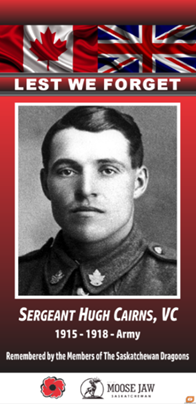The Victoria Cross is the highest accolade the Canadian military gives to personnel who demonstrate “extraordinary valour and devotion to duty while facing hostile forces.”
Eighty-one members of the military received the Victoria Cross for actions in the Boer War (1899 to 1902), First World War (1914-18) and Second World War (1939-45), including four men with Moose Jaw connections.
These four soldiers are featured on downtown banners, along with 19 other men who served their country.
This is part 3 of 7 in a series.
Hugh Cairns
Sgt. Hugh Cairns, VC (Victory Cross), was born in England in 1896 and emigrated to Saskatoon in 1911. On Aug. 2, 1915, he and his brother Albert enlisted in the 65th Battalion CEF. Upon arrival in England, he was sent as a replacement to the 46th Battalion CEF in France.
In January 1917, he was awarded the Distinguished Conduct Medal for his action in leading a party to resupply troops critically short of ammunition. During this, he was wounded. Recognized for his leadership, he was promoted, and by the time the battalion arrived at Valenciennes, he was a sergeant.
The Battle for Valenciennes was the final one before the Armistice. It was for his actions there that he received the Victoria Cross. Named in his memory are a lake in northern Saskatchewan, a school and a street in Saskatoon, and an avenue in Valenciennes, France.
Arthur George Knight
Sgt. Arthur George Knight, VC, originally from Sussex, England, at the age of 25, in 1911, decided to move to Canada, where he lived and worked as a carpenter in Regina.
Three years later, on Dec. 19, 1914, he enlisted in Regina. He was posted to the 46th (Saskatchewan) Battalion, Canadian Expeditionary Force for training. He became a member of the 10th Battalion, Canadian Expeditionary Force on Sept. 28, 1915.
He was a leader and was promoted to sergeant in November 1917. That month, he was awarded the Belgian Croix de Guerre for bravery. He was twice wounded in November 1916 and again in December 1917. He fought at the Somme, Vimy, Passchendaele, Amiens and finally at the Drocourt-Quéant Line.
This very gallant NCO was subsequently fatally wounded. Named in his memory are a lake in northern Saskatchewan, a mountain in Jasper Park, and two streets in Regina, Knight and Sussex.
William J. Milne
Pte. William Johnstone Milne, VC, was born on Dec. 21, 1892, at Wishaw Cambusnethan, Lanarkshire, Scotland. In 1910, he immigrated to Canada, where he worked on the Kirkland farm 40 kilometres west of Moose Jaw.
On Sept. 11, 1915, he walked to Moose Jaw to enlist. Pte. Milne embarked for England on Oct. 23, 1915, with the 46th (Saskatchewan) Battalion and was later transferred to the 16th (Canadian Scottish) Battalion. He fought in the trenches in the Ypres Salient in Belgium.
The 16th Battalion also took part in an attack on the Fabeck Graben Line in September 1916 and on Regina Trench in October 1916 in the Somme area of France before being relieved and moved north to the Vimy sector, north of Arras.
Pte. Milne was awarded a posthumous Victoria Cross and his name is listed on the Vimy Memorial. Milne was the first soldier who had served with the 46th (Saskatchewan) Battalion to be awarded the Victoria Cross.
David Vivian Currie
Lt.-Col. David Vivian Currie, VC, was born in Sutherland, Sask., on July 8, 1912. When the Second World War broke out, he was a mechanic working in Moose Jaw and was serving with the local militia regiment, the King’s Own Rifles of Canada. He volunteered for active duty and was transferred to the South Alberta Regiment as an officer.
While initially trained as an infantry officer, his unit was re-rolled to armoured reconnaissance and he became an armoured officer. When his unit was re-rolled prior to D-Day to an armoured (tank) regiment, he was already a major and was given command of “C” Squadron, South Alberta Regiment (SAR) 29th Armoured Reconnaissance Regiment.
Following the victory of the Falaise Gap — where he earned his VC — Currie continued to fight through battles for the channel ports and into Holland and the Battle of the Scheldt.
In December 1944, he was awarded the Victoria Cross by King George VI for his gallant leadership in closing the Falaise Gap.
After the war, he worked in Quebec until being appointed Sergeant-at-Arms of the Canadian Parliament, a position he held for 18 years. Currie also served as honorary lieutenant colonel of the Saskatchewan Dragoons from 1972 to 1980.
He died in Ottawa on June 24, 1986, and that year, the Moose Jaw Armoury, where he started his military career, was named the Lieutenant-Colonel D.V. Currie VC Armoury. Currie Avenue in Saskatoon is also named in his honour.




